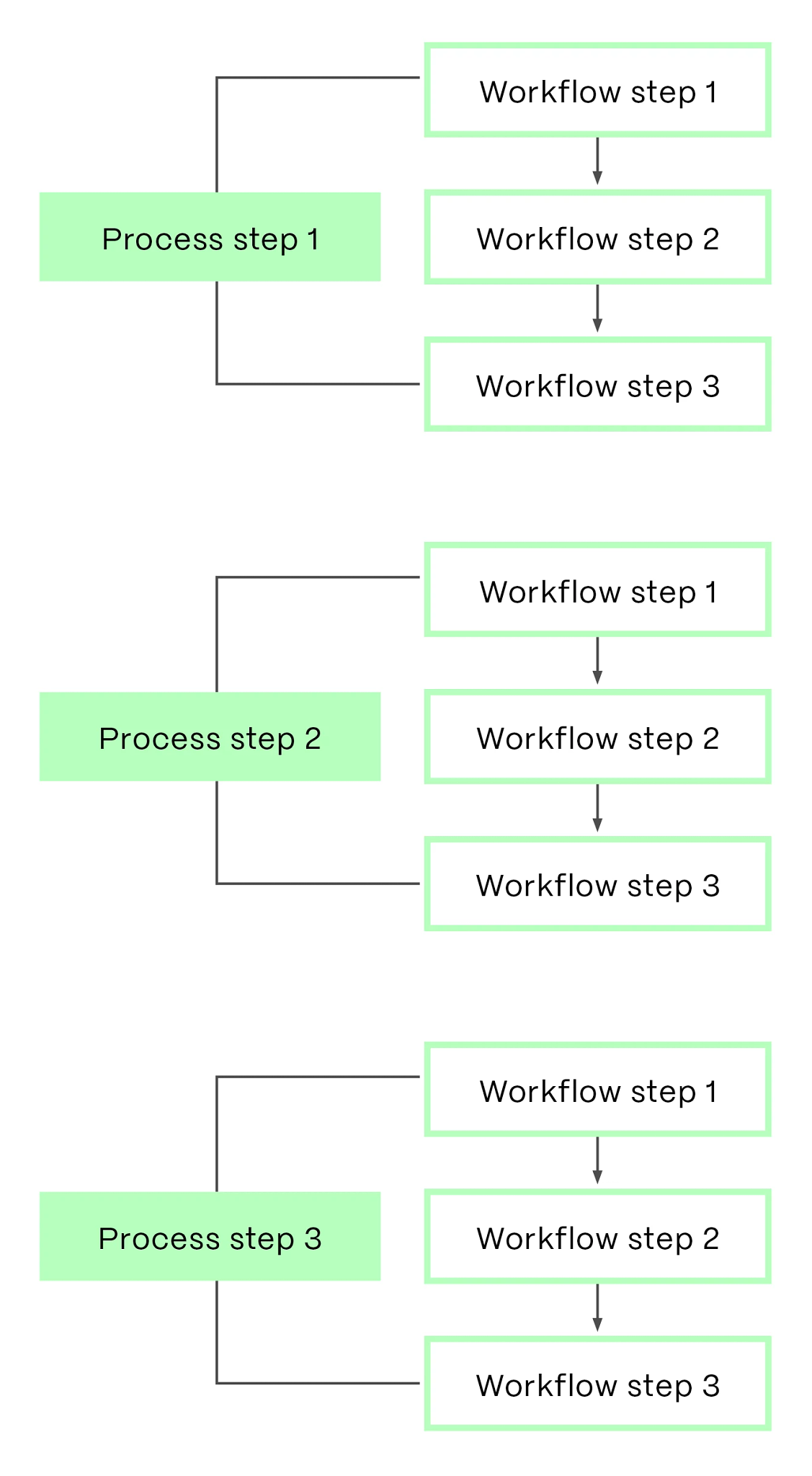
Blog
Workflow vs process: what’s the difference?

The terms “workflow” and “process” are often used interchangeably, but there are important distinctions between the two. Understanding these differences is crucial for businesses that want to streamline operations and enhance productivity. Misunderstanding these concepts can lead to inefficiencies, miscommunication, and ultimately, a negative impact on the bottom line.
In this guide, we’ll cover the difference between process and workflow and how these terms relate to each other. We’ll also outline helpful tips for improving your company’s workflows and processes.
What is the difference between workflow management and process management?
Workflow management means enhancing a series of steps required to complete a task. It involves organizing and automating actions to ensure tasks are completed efficiently and correctly. Workflow management systems often include tools for tracking progress, automating repetitive tasks, and ensuring all necessary steps are followed.
Process management, on the other hand, refers to optimizing repeatable activities that achieve an organizational goal. It’s a broader concept that encompasses workflows but focuses on the overall sequence of activities that lead to a business objective. Effective process management involves continuous evaluation and improvement of these activities to enhance performance and achieve strategic goals.
What is a workflow?
A workflow is a series of activities necessary to complete a task. Each activity is defined by set rules, such as how to carry out the task and what tools to use when doing so. When businesses use workflows to standardize operations, it helps ensure that every team member understands their roles and responsibilities.
Workflows become more efficient when companies use automation tools that allow staff to complete tasks without handling tedious, repetitive steps. It’s estimated that workflow automation could save businesses more than $1 trillion annually by 2025.
Business workflow example
Document approvals are a common business workflow in accounting firms. When a financial report or invoice is ready for review, firms benefit from a standardized series of steps to route it to the appropriate stakeholders. To enhance efficiency, accounting firms can employ workflow automation software to send notifications each time a document’s status is changed. Automation technology also helps make sure that all involved team members have the information needed to approve documents faster.
Related read: Mastering modern accounting workflows: your guide to efficiency and success
What is a process?
A process is a series of repeatable steps an organization uses to achieve a company goal. By optimizing processes, companies improve consistency and efficiency. Maintaining repeatable processes is also important for measuring outcomes because it standardizes operations. Once a company has a baseline for how its key processes are working, it can gain a competitive edge by analyzing performance and making any necessary adjustments.
Business process example
To give an example of a process, let’s say that a financial services company aims to expand its market. Establishing processes to reach that goal lets the company define a series of actions that provide structure and accountability. The processes break down large undertakings — like product diversification, building strategic partnerships, and sales optimization — into smaller, repeatable steps. This structured approach increases efficiency and fosters collaboration. It empowers staff to follow best practices as they work toward an intended outcome, and will ultimately help the company expand into new markets faster.

How are workflows and processes related?
Now that we’ve gone over the differences between processes and workflows, let’s explore similarities between the two.
While a workflow outlines how to complete a certain task, a process is more broad, referring to a series of actions that help a company reach its goals. The end goal of a workflow and a process differ, but because these are similar concepts, they may overlap in function.
Example of a workflow vs a process in business
Think about the workflows used by a construction company. One workflow outlines the steps to create a building’s foundation, detailing task assignments, management, and execution. The overall process for completing the project involves multiple stages, beginning with the foundation, followed by framing, and continuing through every phase of construction. The organizational goal is to complete the building, and this process encompasses numerous specific steps, best practices, and workflows to ensure each task is accomplished efficiently and effectively.

Tips for using a workflow system to improve processes
A workflow system is software designed to automate, manage, and optimize business processes. These tools can coordinate tasks, track progress, and improve communication so team members can complete tasks more efficiently and consistently. If we consider how workflows are incorporated into company processes, we can see how using workflow management software can enhance processes to meet your company's goals.
Consider the construction company example above. If a workflow system is used to manage the creation of the building’s foundation, the crew gains several advantages to improve how tasks get completed. The company would improve efficiency by automating aspects of the work such as notifications and alerts on status changes to the project. Project managers would be able to leave comments about special requirements for the foundation, streamlining communication and helping the workflow carry on without a hitch. By improving the workflow for the foundation, this part of the project can proceed more smoothly, contributing to a better optimized process.
Workflow automation best practices
Companies across industries can benefit from using a workflow system. To get the most out of these tools, it’s important to follow best practices for improving processes with workflow software:
- Define existing workflows: Document your current workflows before implementing a workflow system to account for every workflow that’s needed. This will help in identifying gaps and areas for improvement.
- Automate routine tasks: Use workflow automation solutions to reduce manual effort and take over tedious, time-consuming tasks. This not only increases efficiency but also reduces the likelihood of errors.
- Monitor performance: Use the system to regularly track key performance indicators, helping you identify bottlenecks and inefficiencies. By analyzing this data, you can continuously improve your workflows.
- Encourage collaboration: Use system communication tools to enhance teamwork and information sharing. This ensures everyone is on the same page and can contribute to the workflow's success.
- Integrate systems: Integrate your system with other business tools for seamless data flow. This integration allows for more efficient operations and better data management.
Workflow vs process: now you know the difference
Understanding the difference between workflows and processes is essential for enhancing business operations. While workflows focus on the specific steps needed to complete tasks, processes encompass a series of repeatable actions aimed at achieving broader organizational goals. Both are crucial for improving efficiency, consistency, and overall productivity.
By effectively managing and optimizing workflows and processes, businesses can streamline operations, reduce errors, and enhance cross-team collaboration. Implementing workflow management software and automation tools can significantly contribute to these improvements by automating routine tasks, tracking performance, and integrating with other business systems.
In this guide, we’ve explored the distinctions and relationships between workflows and processes, provided practical examples from various industries, and shared tips for leveraging workflow systems to optimize processes. Now, it's up to you to apply these insights to elevate your business operations, driving efficiency and success.
Related Resources

Blog